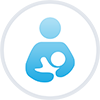How to build your core strength after birth
Postpartum | Wellbeing | | Charlie Launder
1. Your bump will take some time to go down.
This is completely normal. It is not because you are not strong and it certainly doesn’t mean you need to hit the sit ups immediately. Your uterus takes time to contract back down to its regular size, organs are going back to their original places, and there is a lot of healing going on – so no wonder it takes a little while for the bump to go down! Forget the films that show women walking out of hospital in their jeans. It’s not happening.
2. What is a diastasis recti and do I have it?
You will most likely have heard the term diastasis recti through your pregnancy, but you might not know what it is, whether you have it and what it means if you do?
Diastasis recti is the separation of the muscles along the midline of the abdomen, typically as seen in women during and after pregnancy. 100% of women will have it by the end of their pregnancy as our growing bumps cause the muscles to stretch apart. It is totally normal, and most often it will naturally come back together some weeks after pregnancy; however, sometimes it needs a bit of work to help it.
Your physio or doctor should feel for it when you have your 6 week check, but you can ask them to if they don’t offer. If you want to check for yourself, you can feel with your fingers in a lying-down position at home, although this won’t give you the full picture that a physio or doctor could give you. You are looking for a gap down the midline of your stomach or around your belly button. If you are unsure or concerned then please seek advice from a women’s health physio. There’s no need to worry if you do still have a separation after 6 weeks. This is very common and doesn’t mean that you can’t heal it and be stronger than ever!
If you do, it is even more important than ever to take note of number 3 below, but also to keep an eye on your stomach when doing exercise. If you notice that there is a doming shape, or a sinking shape down the midline or around the belly button then that is your body signalling to you that the movement that you’re doing is not being managed very well by your core. It is not dangerous, so you needn’t be afraid, but do pay attention to it and adapt the exercise if you notice it.
3. Sit ups are not the answer!!
I know that we are led to believe that a sit up is the be all and end all for core strength but there are so many more effective exercises to be doing, especially after pregnancy.
We need to build strength from the very base of your core first. We need to engage those teeny tiny muscles that we can’t even see. Take this opportunity to build a core stronger than you’ve ever had, as we are basically starting from scratch here.
The first time you start using your core again should be through breathing exercises. Reconnecting or learning how to connect your breath to your core is a skill that will come in very handy later on. Then we start to add small leg movements to increase the work for your core, developing to double leg movements and so on but it is imperative that you go at a pace that works for you. You may find it frustrating as you want to get straight to the ‘hard’ stuff where you feel the burn, but if you don’t get this stuff right now, you’ll struggle later down the line.
4. Extra fat around your tummy does not mean a weak core
It is only natural for our bodies to store extra fat around our tummies after we have had our babies. This is a maternal fat store, and don’t forget your skin has stretched monumentally around this area over the last 9 or so months, so give it some time.
What I often hear is: “I can’t shift the weight around my tummy. What core exercises are best?” And unfortunately, no core exercises are going to reduce body fat. In fact, we can’t spot-reduce body fat at all. You will start to lose body fat when your energy output is larger than your energy input – i.e. through a combination of diet and exercise – not with hundreds of core exercises.
It’s important to note that you can have a very strong core and a fat tummy, so be mindful not to confuse body fat with weakness.
5. You can strengthen your core with every single exercise.
What I mean by this is that it doesn’t have to be a ‘core’ exercise to work those abdominal muscles. Your core is working when you do squats, press ups, lunges, you name it!
If you focus on maintaining correct posture when you do each and every exercise, I promise your core will be working very hard. A sneaky way to increase core activation is to offset your balance. Hold a weight in just one arm when doing your lunges, or do a single sided shoulder press and your core will have to kick in to make sure you stay upright. Just make sure you are using your core, as it protects your back.
Your workout doesn’t have to be filled with planks and crunches to get those abdominals working.


